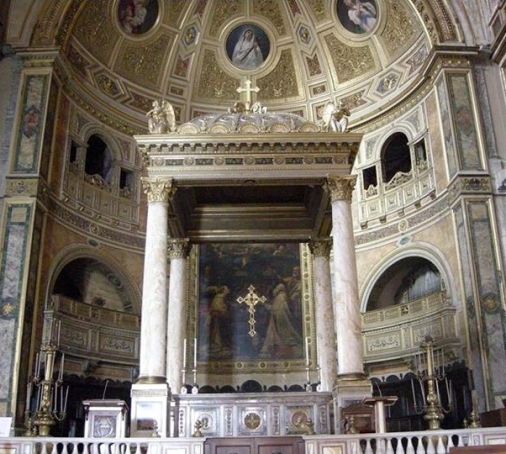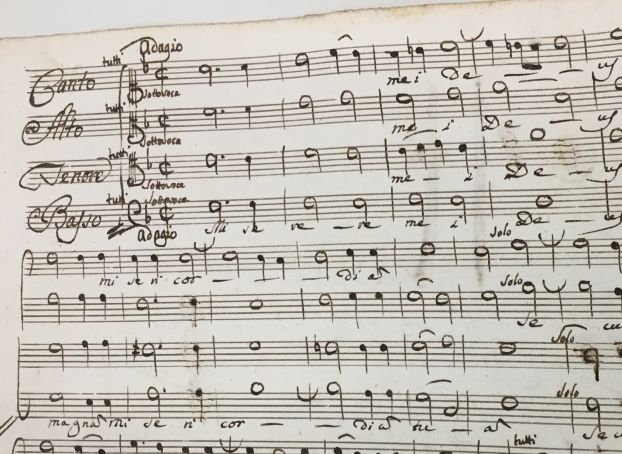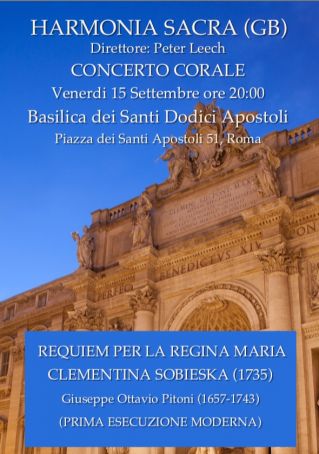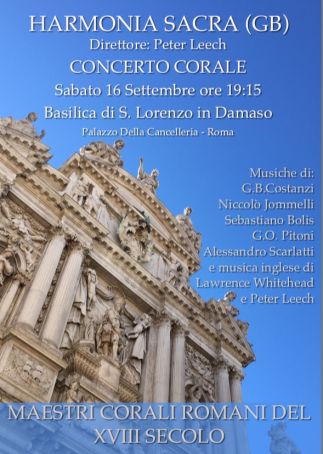By Peter Leech.
A British choir revives the forgotten glories of Rome's 18th-century music with two ground-breaking concerts this month.
Harmonia Sacra was formed in Bristol in 2009 by the choir's conductor, Australian-born Peter Leech, who is based in the School of Music at Cardiff University. The choir has rapidly established a reputation for dynamic and innovative concerts and recordings of late Renaissance and Baroque choral music, performed to the highest standards. Embarking on its first overseas trip, the choir will give two concerts in Rome on 15 and 16 September.
Mainstream academic music texts will often tell you that anything interesting, as far as sacred music in 18th-century Rome is concerned, more or less came to an end with the death of Alessandro Scarlatti in 1725. They also tend to claim that many of his colleagues and successors were slavish imitators of the Palestrina style who did nothing to advance sacred music in a city apparently dominated by papal conservatism.
While it is undoubtedly true that in the Sistine Chapel the stile antico prevailed until the end of the 1700s (as indeed it did in Rome’s four papal basilicas), in many important parish churches in Rome sacred music was anything but conservative: in the hands of leading composers, it reached new heights of expressive power with distinctly modern and, in the wider European sense, classical flavours.
Cardinal Henry Benedict Stuart
One such church was S. Lorenzo in Damaso, attached to the Cancelleria, the palace of the vice-chancellor of the Roman Church. In the early 18th century, the cardinal-priest of S. Lorenzo was Pietro Ottoboni (1667–1740), famous patron of Arcangelo Corelli. From 1763, this church came under the protection of Cardinal Henry Benedict Stuart (1725–1807), who had been elevated to the sacred purple in 1747.

As the brother of Bonnie Prince Charlie and grandson of King James II of England, Henry Benedict Stuart was devout, sincere and musically trained. He spent lavishly on sacred music at S. Lorenzo, where composers such as Giovanni Battista Costanzi and Sebastiano Bolis enjoyed particular favour.
Santini collection
My interest in Roman sacred music of the 18th century had for many years been confined to composers active before 1760, such as Alessandro and Domenico Scarlatti, Pietro Paolo Bencini and Giuseppe Pitoni. The second half of the century had never been a major concern of mine until 2011, when I started looking at music manuscripts preserved in the vast Santini collection in Münster, Germany. I was intrigued to come across the dedication page of a Mass setting with its composer, Sebastiano Bolis (c.1750–1804), described as maestro di cappella to Cardinal Henry Benedict Stuart at S. Lorenzo in Damaso.
While Cardinal Henry’s patronage of painting, sculpture and poetry is well known, his patronage of sacred music, after he was made a cardinal by Pope Benedict XIV in 1747, is a subject hitherto entirely untouched by modern scholarship.
Bolis, whose music has languished in obscurity for nearly 250 years, has now become one of my principal research focuses: over several years, I have transcribed and edited many sacred works which Bolis composed for Cardinal Henry at S. Lorenzo in Damaso between 1778 and the mid-1790s. Bolis’s music is demonstrably fresh, modern and appealing, the product of a master who could turn his hand to any idiom, whether penitential, celebratory or reverently contemplative. His remarkable stylistic flexibility can make us sigh, laugh or cry, and it is no wonder that Henry Benedict supported him so fervently and without question.
Context of time and place
My first task was to transcribe as much of this music as I could, partly as a way of fully understanding the style of a composer who is entirely new to modern English-speaking musicology (and, as far as Italian musicologists are concerned, known by name to only a few), but also as a way of setting it in the context of its time and place.
I also decided it was now time to dive head first into the vast 40-volume ecclesiastical diary kept by Cardinal Henry’s secretary, Giovanni Landò, held by the British Library in London. This source has been largely avoided by scholars of Jacobite history, perhaps because one of its 19th-century detractors, James Dennistoun, described it as a “heap of puerile prolixity”.

Not only does the Landò diary reveal much about the involvement of Bolis in the provision of sacred music for Cardinal Henry, but it also confirms his role as maestro di cappella at two of the principal venues for Henry’s patronage of sacred music – the church of S. Lorenzo in Damaso and the cathedral at Frascati, where Henry was bishop from 1761.
The Landò diary also contains references to music which Bolis provided for Carnival and Lent at Frascati, as well as the names of many other composers directly or indirectly associated with Cardinal Henry. From 1778 (the year in which Bolis succeeded Giovanni Battista Costanzi as maestro di cappella) onwards, Bolis provided new sacred works for S. Lorenzo on a regular basis, one of the most important occasions being the patronal feast, 10 August.
Forgotten phenomena
Having dusted off centuries of obscurity and neglect, it soon became apparent to me that, through the music of Bolis and his contemporaries, I was revealing two forgotten phenomena, the fabulous music of a Roman composer who deserves modern recognition, and the musical patronage of a cardinal who had for far too long been resolutely denounced by Whig historians as a pompous irrelevancy.

The music of Bolis and his contemporaries, as well as the patronage of Henry Benedict Stuart should be of interest to anyone with a passion for the Rome of Johann Winckelmann and Johann Wolfgang von Goethe, of Pompeo Batoni and Charles Burney, the Rome that was a magnificent melting pot of artists, writers and musicians – indeed, the Rome of the Grand Tour.
The two forthcoming concerts in Rome provide a wonderful opportunity to bring the music of Bolis and his Roman contemporaries back to life and to demonstrate the discerning musical taste and patronage of Cardinal Henry Benedict Stuart, who deserves to be ranked alongside Cardinal Pietro Ottoboni as one of the leading musical patrons in 18th-century Rome.
ROME CONCERTS
Harmonia Sacra gives its first Rome concert at the Church of the SS XII Apostoli, Piazza dei SS Apostoli 51, on Friday 15 September at 20.00. This will include the first modern performance in Rome of some of the music composed by Giuseppe Ottavio Pitoni (1657–1743) for the Requiem of Maria Clementina Sobieska Stuart, the wife of Charles Francis Edward Stuart, the Old Pretender, which took place at the SS XII Apostoli in 1735.
The choir's second concert will take place at the Church of S. Lorenzo in Damaso, Piazza della Cancelleria 1 on Saturday 16 September at 19.15. This will feature the first modern performances of three sacred works by Sebastiano Bolis (c.1750-1804).

Both concerts will include a number of contrasting, sacred choral works by contemporary British and American composers, including Eric Whitacre, James Macmillan, Peter Leech and Lawrence Whitehead. Admission to both concerts is free. On Sunday 17 September Harmonia Sacra has been invited to provide the music for the Capitular Mass at St Peter’s Basilica in the Vatican, at 10.30.
Peter Leech. Born in Australia in 1967, Dr Peter Leech is a professional choral and orchestral conductor, musicologist, composer, singer, keyboard player and lecturer based at the School of Music at Cardiff University, UK. He specialises in English court music (1600–1750), music of the British Catholic community and its continental European diaspora (1600–1800) and European sacred music (1550–1800), and he has published widely. In 2003, at the Concorso Internazionale per Direttori di Coro "Mariele Ventre" in Bologna, he won first prize and was awarded the Coppa d'Argento del Presidente della Repubblica; and he subsequently appeared at the 2005 Ravenna Festival directing Coro Euridice from Bologna. He is currently engaged in further research on 17th- and early 18th-century English Jesuit musicians and is preparing a cultural biography of Cardinal Henry Benedict Stuart (1725–1807).
This article was published in the September 2017 edition of Wanted in Rome magazine.

















